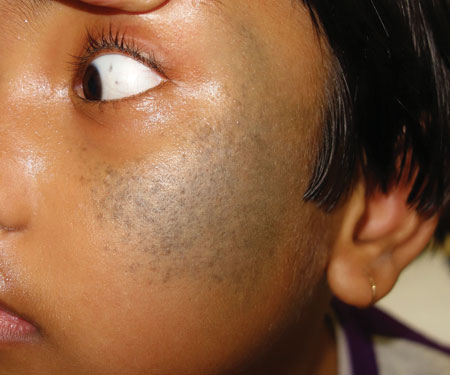A 6-year-old girl presented with an asymptomatic dark patch over the
left side of her face. Her parents first noticed a small patch of bluish
discoloration, when she was two-months-old, that gradually increased in
size and became darker in color. On examination, mottled blue-gray
macules were seen over the left cheek extending to the left temporal
area (Fig. I). In addition, two small
blue-black spots were seen on the sclera of her left eye. Oral mucosa,
hairs, and nails were normal. Systemic examination was non-contributory.
Based on the distinct color, morphology, and location of the lesion, the
condition was diagnosed as nevus of Ota.
 |
|
Fig. 1 Mottled blue-grey macules of
Nevus of Ota.
|
Nevus of Ota is believed to occur due to migration
arrest of melanocytes on their way to the epidermis from the neural
crest. It typically occurs as a persistent, speckled, blue-black, or
slate-gray hyperpigmentation in the distribution of the ophthalmic and
maxillary division of the trigeminal nerve. The bluish color is due to
scattering of light by dermal melanin (Tyndall phenomenon). Though
mostly present at birth, it can also appear later; 80% of the cases
occur in females. Unilateral involvement is seen in 95% of the cases.
Patchy scleral pigmentation is seen in two-third of the cases.
Pigmentation may also be seen in the oral mucosa, cornea, pharynx, and
nasal mucosa. The condition is generally benign and persists for life.
The treatment of choice for the condition is laser surgery; cosmetic
cover-up may also be used.

